Day 2 of a three day Late Spring Tour today. It was originally forecast to be sunny today, but by this morning that had changed to cloud all day. So it was to be. It was rather misty first thing, but the cloud lifted through the day. There was still a cool breeze but at least it had dropped considerably compared to yesterday, which meant it didn’t feel quite as cold.
Given the early mist, we headed round to Cley to start the day, thinking we could get out of the weather in the hides. As we walked out to the hides, a Cetti’s Warbler shouted at us from deep in the brambles by the ditch – good to head as numbers have dropped dramatically after the cold winter. A Grey Heron was standing motionless in the wet grass by the boardwalk as we passed. We heard a Bearded Tit call and turned to see it fly across and drop straight down into the reeds.
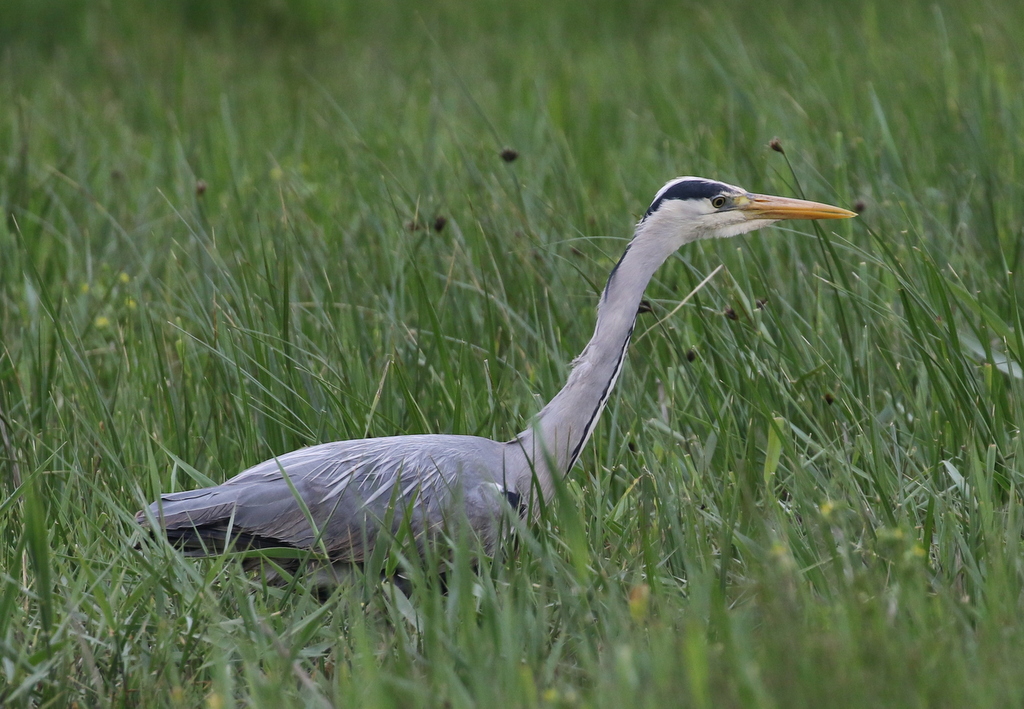
From the shelter of Dauke’s Hide, we had a scan of Simmond’s Scrape first. There were a few waders to be found on here. Two Common Sandpipers and two Tundra Ringed Plovers were feeding around the edge of the islands and another seven Tundra Ringed Plovers dropped in to join them. There were two Little Ringed Plovers on here too and a Greenshank which was fast asleep on the island at the back.
The scrapes are dominated by the Avocets now, many of which have small juveniles already. We could see several groups of little ones out on the scrapes or sheltering beneath the adults. The Avocets are very aggressive and will chase off anything which lands anywhere near. It was funny to watch them trying to battle with the local Shelducks.
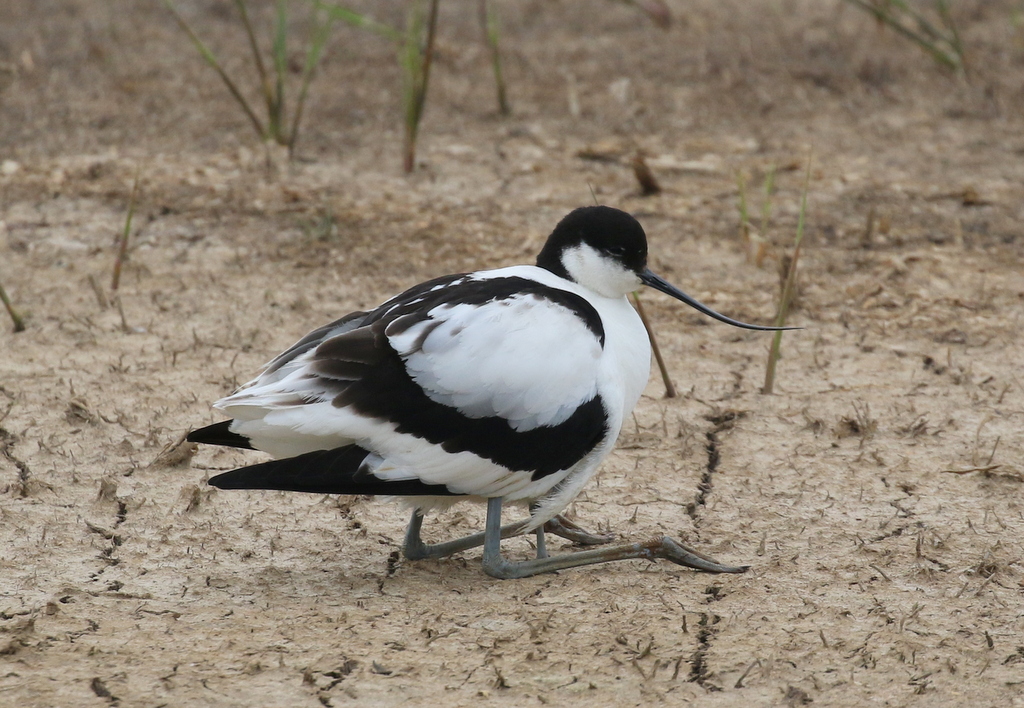
Lots of Sand Martins were flying backwards and forwards low over the reeds and the scrapes, looking for insects, together with a few House Martins for company. A couple of Marsh Harriers patrolled the reedbed at the back. Two pairs of Tufted Duck were swimming around on the ditch right in front of the hide.
Looking across to Pat’s Pool, the first thing we noticed were the Ruff. There were five of them on here, all males and all different! One male was particularly striking, with a fully grown rufous ruff and black crest feathers. The breeding plumage of the other Ruffs was not quite as well developed – a second rufous one and a black one lacked the full crest feathers, as did a white one, and another blackish one didn’t have much of a ruff yet. Unfortunately there was no female today, for them to display to.

There were also still a good number of Black-tailed Godwits on Pat’s Pool, mostly asleep and loafing around on the edge of one of the islands. A second Greenshank was feeding over in a sheltered bay in the far corner but whenever it ventured out into the open, it was chased back in by one of the Avocets.
It was cool in the hides, to we decided to head back to the Visitor Centre to warm up over a cup of coffee. On the way back along the boardwalk, we heard Bearded Tits calling again and looked up to see a female perched in the reeds beside the path ahead of us. A cracking male then flew in and landed just below, before the two of them flew across the boardwalk to the reeds the other side. They were followed by two juvenile Bearded Tits, still with only partly grown tails. We walked up to where they had crossed and had a great view of them climbing up and down in the reeds.
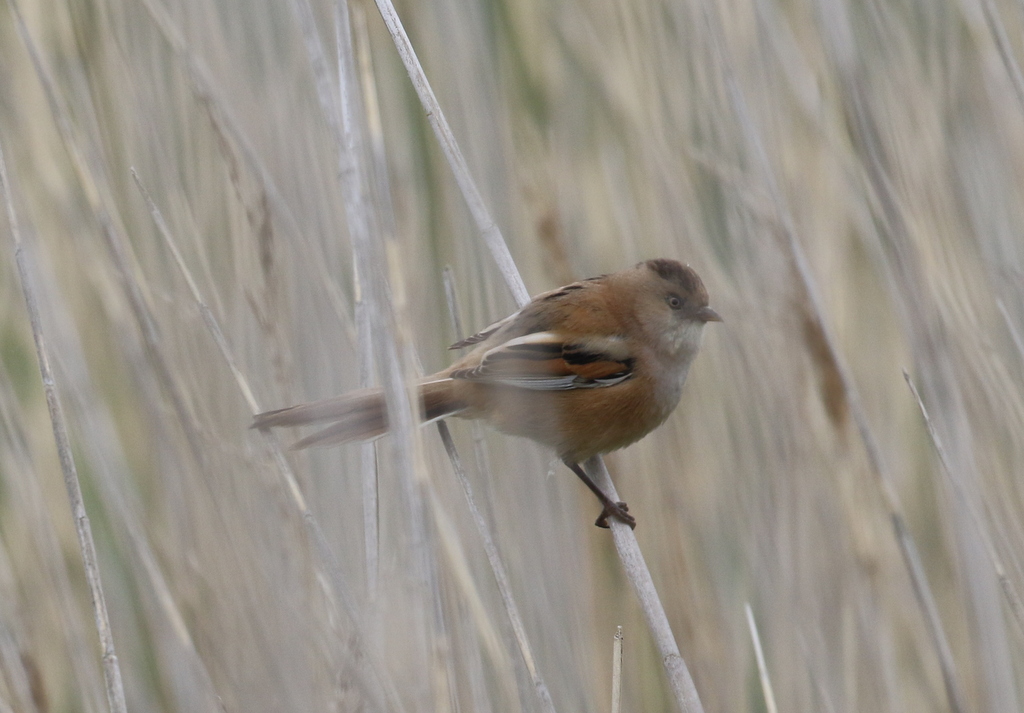
As we got back to the bridge across the ditch by the road, we heard the Cetti’s Warbler again so we stopped to see if we could find it. We could see a Reed Warbler flicking around low in the reeds along the edge of the water. Then something else flew out, chased it, and then landed in the brambles. It was the Cetti’s Warbler. It sang once and we could just see it perched on the edge of the bush before it dropped into the vegetation.
After our coffee break, we had a look round at the Iron Road. The pool here was fairly quiet today – just a couple of Redshanks and Lapwings and a single Little Ringed Plover lurking in the reeds at the back.
As we walked round to Babcock Hide, a pair of Egyptian Geese flew over and landed in the field the other side of the road. A well-grown Lapwing chick was trying to hide in the grass by the path while one of the adults flew round above calling agitatedly. The pool in front of Babcock Hide was a bit disappointing today. Apart from lots of Greylags, there were just a few Avocets, including a pair with a single chick.
We decided to try our luck out on East Bank instead. The low cloud had lifted a little now and it had started to brighten up a touch. Two male Marsh Harriers had a brief tussle over the reedbed as we got out of the car, before one then headed off over Pope’s Marsh. There were a few Lapwings and Redshanks out on the grazing marsh and we picked up a distant Common Sandpiper on Pope’s Pool. A single drake Wigeon and three Teal on the north end of the Serpentine were notable. Most of the ones that spent the winter here have long since departed, so it will be interesting to see how long these ones stay.
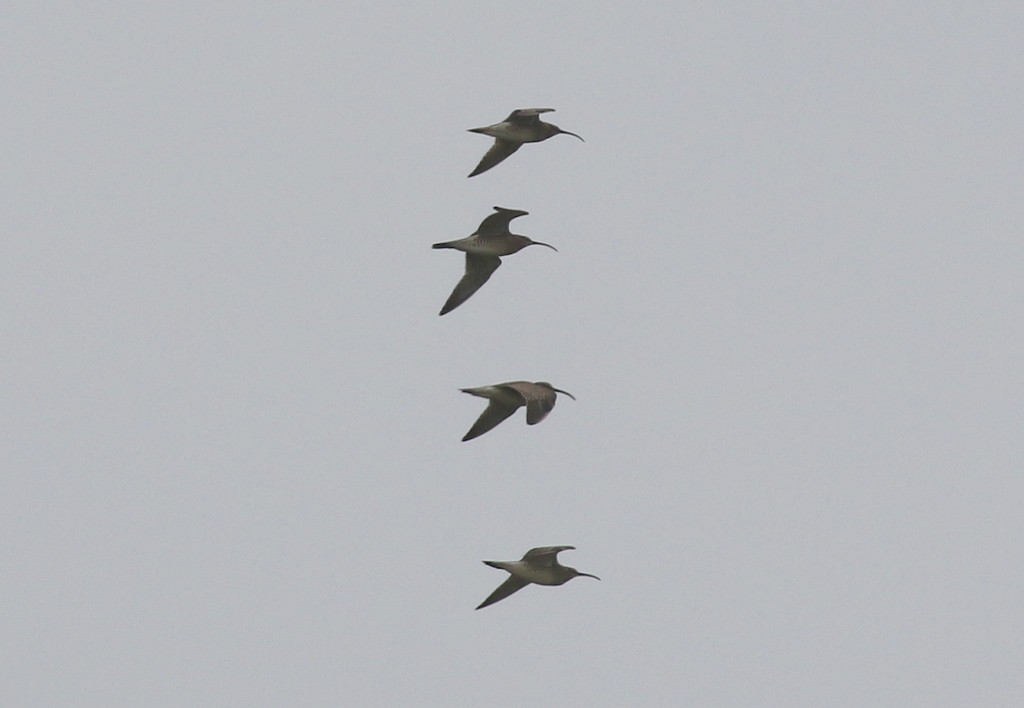
As we continued on to Arnold’s Marsh, we noticed four largish waders flying in over the reedbed. They were Whimbrel – we could see there down-curved bills, not as long as a Curlew. They dropped down onto Arnold’s so we continued on to there and got them in the scope. We could see their distinctive striped head patterns. They didn’t stay long though, only around 10 minutes. After a preen and a doze, they took off and headed out over the beach and out to sea, presumably on their way to Scandinavia.
There were lots of Sandwich Terns on the island at the back again – through the scope we could see their shaggy black crests and mostly black bills. There were not too many waders on here today, but we could see another five Tundra Ringed Plovers and a smart summer plumage Turnstone.
We couldn’t come all this way without a quick look at the sea, so we continued on to the beach. There were lots of Little Terns feeding just offshore, flying up and down just behind the breakers and occasionally diving straight down into the water.
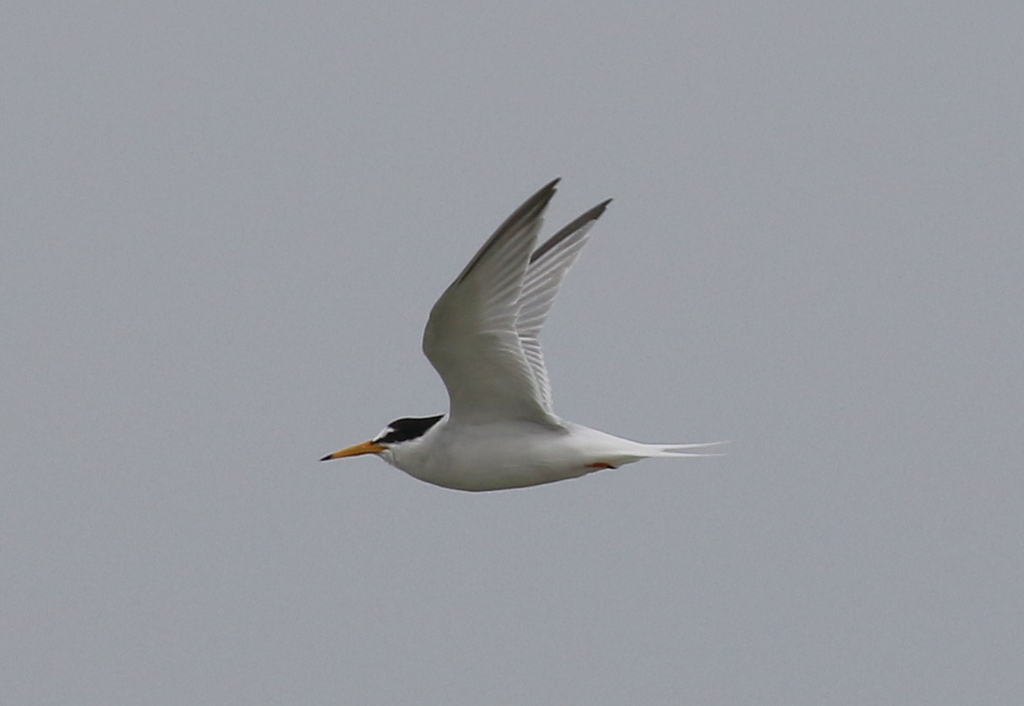
On the walk back, we had nice views of a male Bearded Tit briefly in the reeds down below the bank. It appeared to be carrying a feather, possibly nest material, before it shot off back behind us along the ditch. One of the Marsh Harriers also showed very nicely, flying round over the reeds just ahead of us, before heading out across the grazing marshes, chased by various Avocets and Lapwings.
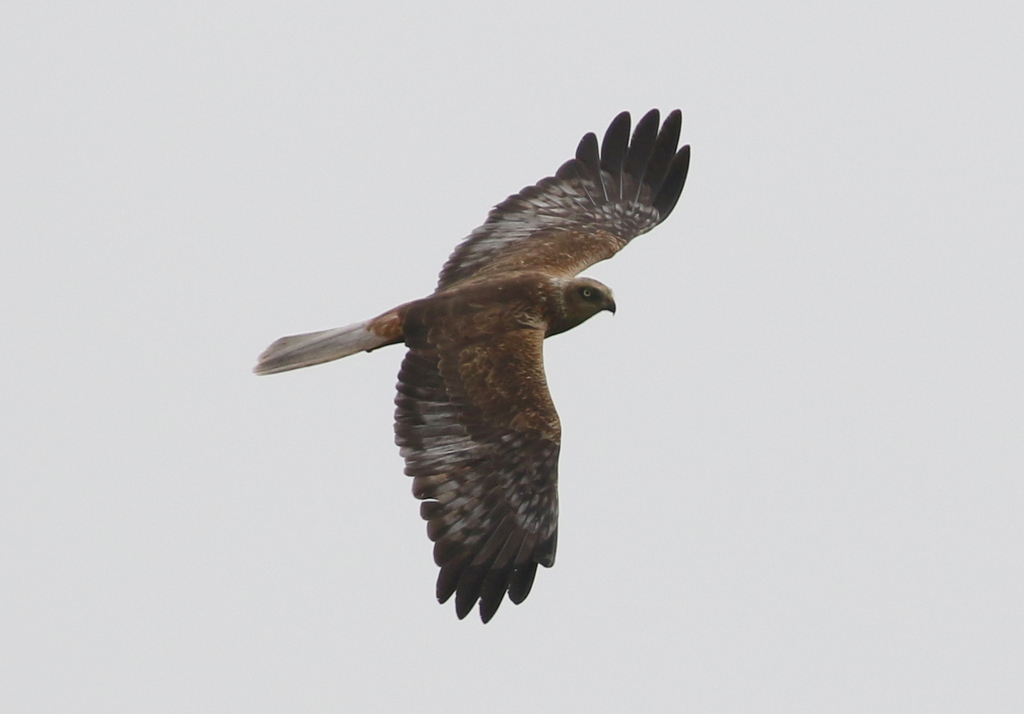
Given the fresh breeze, we decided to head round to the beach car park and eat our lunch in the shelter there. A few parties of Sandwich Terns flew past over the Eye Field while we ate. Afterwards, we had a quick walk out to North Scrape.
We couldn’t see anything of note on Billy’s Wash, but as we got to the shingle behind North Scrape, a Wheatear flew up. It was a male, quite a bright pale one. It landed on the fence beyond briefly, then flew again, up onto the top of the screen overlooking the scrape. It dropped down onto the picnic table and we thought we might be able to get round for a closer look, but before we could get there it was off again, down onto the grazing marsh beyond.
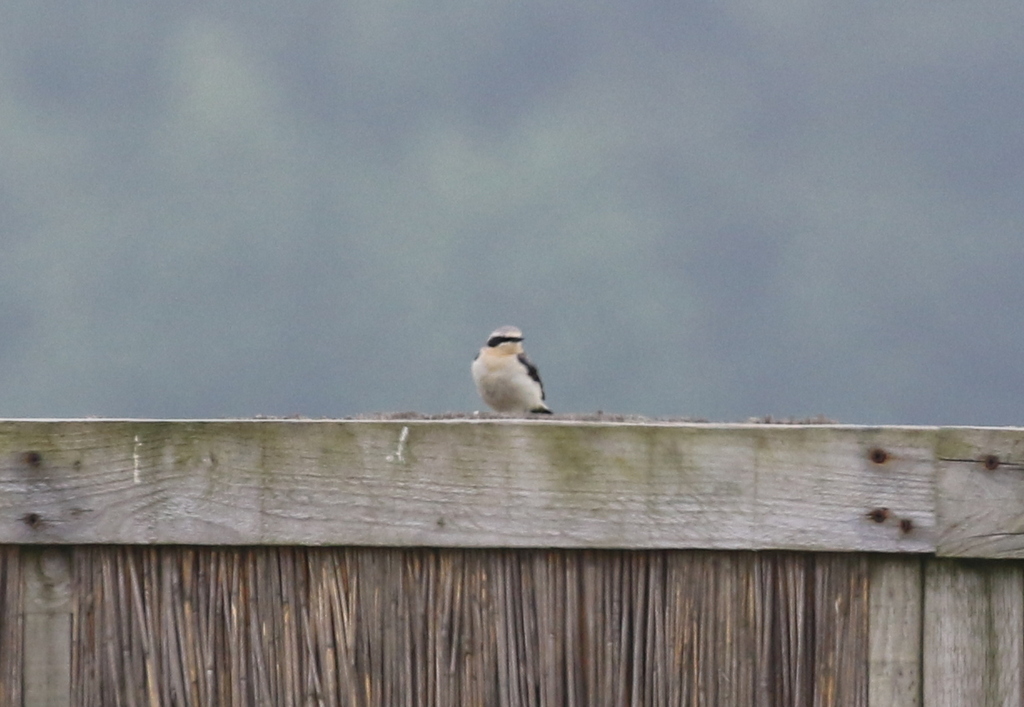
There was nothing of note on North Scrape, but at that point we received a message to say that there was a White-winged Black Tern along the coast at Burnham Overy. We decided to head round there to see if we could see it.
As we walked out along the track which cuts across the grazing marshes, we heard two Lesser Whitethroats singing in the hedge. In typical fashion, we had a couple of quick glimpses as they flew between bushes, dropping straight into cover. One or two Reed Warblers were singing from the ditch beside the path.
We could see the White-winged Black Tern before we got to the seawall, visible above the reeds as it flew round over the pool in the middle, but it was a better view once we got up to the top. What a stunning bird! Its mostly white upperwings and tail contrasted with its jet black body. When it turned, we could see its black underwing coverts.
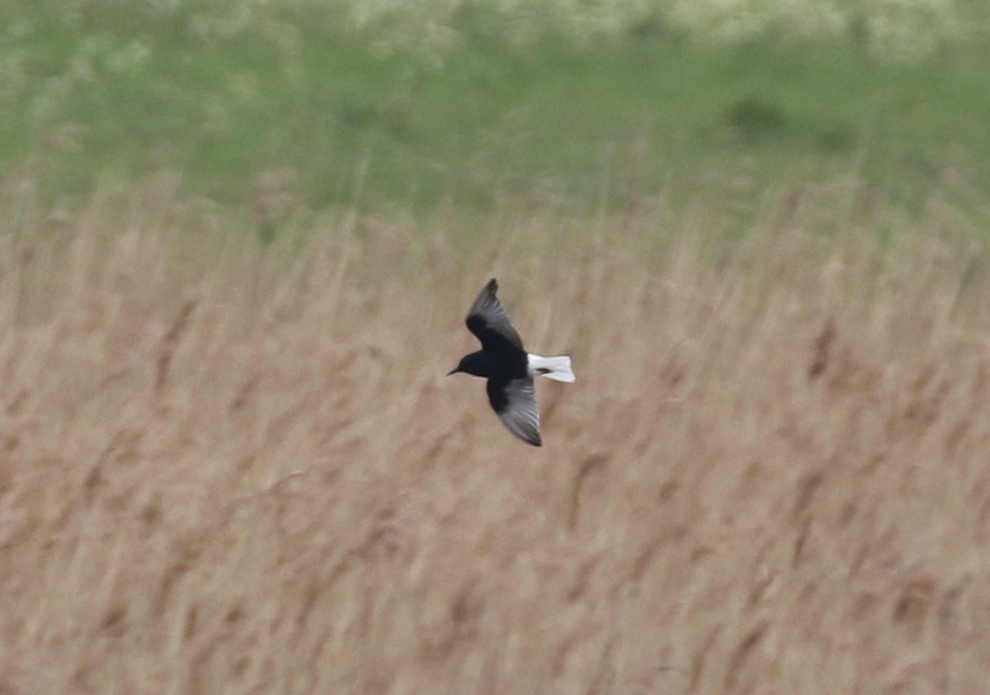
The White-winged Black Tern was flying round over the pool with very buoyant wingbeats, occasionally dropping down to the water’s surface, looking for insects. A great bird to watch!
While we were watching the tern, we kept one eye out over the harbour the other side and we noticed a harrier come up over the saltmarsh beyond the harbour channel. It was very slim, with narrow, pointed wings and through the scope we could see the white patch on its uppertail coverts and its faded buff/orange underparts, with a darker hood. It was a Montagu’s Harrier, a young one, a 2nd calendar year. We watched it hunting over the saltmarsh before it gradually worked its way back and out of view.
One or two Spoonbills flew past as we stood up on the bank. As we made our way back across the grazing marshes, we heard a Greenshank calling. While we were looking for it, we turned to see a Spoonbill flying low right over our heads!
There was still a little time left before we had planned to finish today, so we headed round to Wells Woods. A Wood Sandpiper had been reported earlier, on the marshes south of the pines, although the latest update suggested it might have flown off. Still, we walked out for a look. On our way out, another Greenshank flew over the pines calling.
As we scanned the pools and flooded grassland, one of the group spotted a wader which was disturbed from the wet grass by a gull flapping nearby. It was the Wood Sandpiper. Through the scope, we got a good look at it, noting its white spangled upperparts and striking pale supercilium.

It had proved to be a very productive afternoon and that was a nice way to end the day’s activities. With more to come later tonight!
Nightjar Evening
After couple of hours off to recover and get something to eat, we met again early evening. We headed out to look for owls first. It was still cool and rather breezy – not ideal weather, though not the forecast fog thankfully. We drove to an area of farm buildings where we know Little Owls breed first.
There was no sign of any Little Owls at first, it was a bit too cold to find them out basking! As we walked round, we saw a Brown Hares and a couple of Red-legged Partridge on a farm track. A Grey Partridge ran out across a recently planted potato field, and stood up nicely on the ridges, showing off its black belly patch.
We eventually found a Little Owl but it was hiding on the ridge of one of the farm buildings, tucked in under the cowl on the top of the roof. It was back on to us and we could just see its head and shoulders. It was not a great view of one, but better than nothing!
Our next target was to look for Barn Owls. We drove down to the back of Cley, figuring it might be sheltered from the wind here, and immediately spotted a white shape on a post by the road, a Barn Owl. We drove past and parked some distance beyond, hoping we might be able to see it without disturbing it but it flew off as we got out. It landed again on another post across the field, where we could see it in the scope.
It was a strikingly white Barn Owl, much paler than a normal one, a known individual which has been in the area for a year or so now. Then it took off again and flew straight back towards us. For about ten minutes, we watched as it flew around hunting in front of us. Great views! A second Barn Owl appeared further back, a normal coloured one, landing on a bush briefly before flying off over the road the other side.

Eventually we had to tear ourselves away from the Barn Owl and head up to the heath for the evening’s main event. As we walked out to the middle of the heath, we could hear a Garden Warbler singing from some dense bushes. A male Stonechat perched up nicely where we could see it. It was still rather cool, but we were sheltered from the wind by the trees.
It wasn’t long before we heard the first Woodcock calling, and looked across to see one flying straight towards us. It was roding. the display flight of the male, flying round over its territory with stiff flapping wingbeats. We would see it or hear it several times over the course of the evening.
Shortly afterwards, the first Nightjar started churring. We positioned ourselves to try to see it, hoping it would fly up to one of its favourite perches to churr. But suddenly two birds appeared, flying up from the edge of the trees. We could see they were both males, both with white wing flashes and white corners to their tails, and they were chasing each other.
The two Nightjars flew in and out of the trees, calling and wing clapping. They held their tails fanned and at an angle to show off the white spots to maximum effect. They landed down on the ground briefly, out of view, but were quickly up again, chasing each other out over the heath. One circled back and flew round just above our heads, calling – amazing views!
Then both the Nightjars headed away and we could one of them churring some way further over. We tried to make our way over as quickly as possible, as sure enough it was on a favoured branch, but just as we got within scope range it was off again. It was great to listen to them churring, but they wouldn’t stay still for long this evening and quickly started to go quiet.
It had been a fantastic display anyway, so we decided to call it a night. We walked back to the car to the sound of more Nightjars churring either side.
















